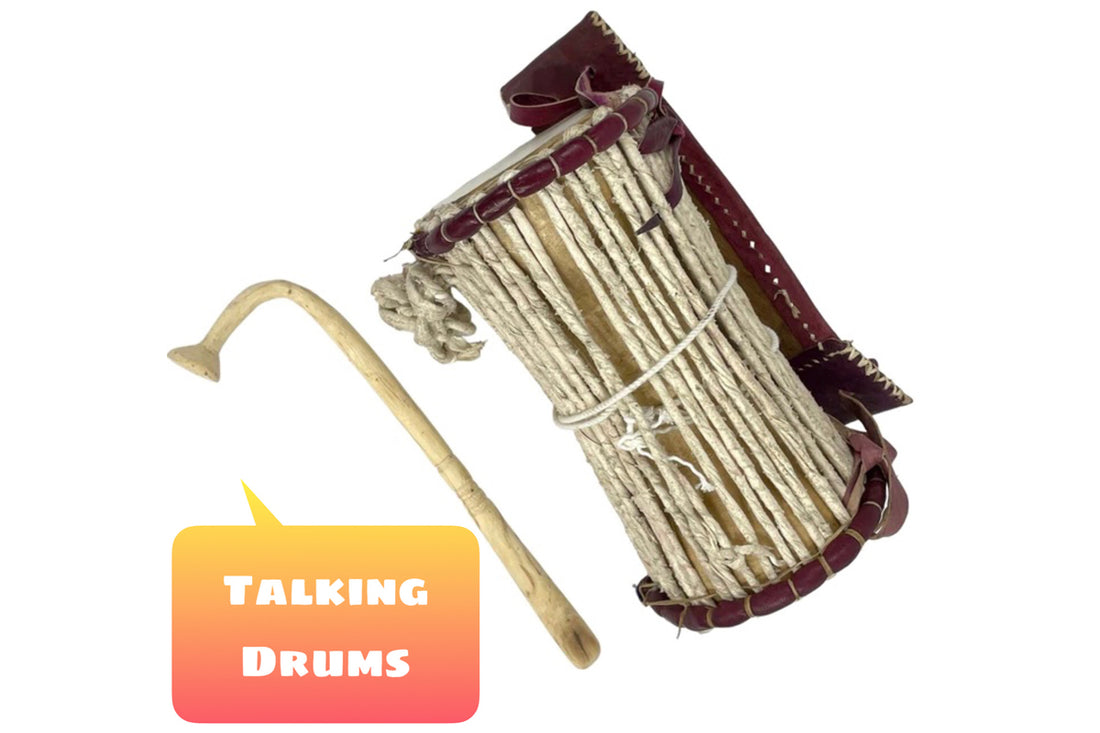Talking Drums are a fascinating and versatile family of percussive instruments with a long history as both a rhythmic and communicative device. While they may take their name mainly for their changeable pitch – which is in many ways is evocative of the human voice – they are also used for "talking" in a more practical sense. Historically, these drums are used to announce important life events, as well as news and information, and to signal the beginning and end of battles. Messages sent via Talking Drum can traverse great distances, depending on the size and resonance of the instrument, and whether another drummer picks up the message to send it along. In the days before phones and email, this instrument was not only a welcome form of entertainment, but on occasion it was an invaluable tool for survival.
The hand-held variety of Talking Drum is constructed by first turning a suitable piece of wood on a lathe into an hourglass shape. A membrane or drum head (often goat, sheep, or calf skin) is soaked and then tied in place over both ends of the drum frame. Ropes are then interlaced from one drum head to the other until both sides are securely fastened. This design helps to ensure that the instrument is resonant, with good tonal clarity. Tension on the side ropes that run from one end of the drum to the other will affect the pitch, allowing for precise tonal control in the hands of an experienced player. (Video source here)
To play a Talking Drum, the drum body is placed under the non-dominant arm with a shoulder strap to secure it in place, leaving the dominant hand free to strike the drum using a curved stick. By squeezing the cords of the drum under the arm, the pitch of each stuck note will resonate at a different frequency. The squeezing arm also has a free hand that can be used to further manipulate cables on the side of the drum, or selectively hit and dampen the drum head. (Video source here)
Talking Drums are common to many communities around West Africa, including Nigeria, Ghana, Cameroon, Senegal, Togo, and the Benin Republic. Different communities have different names for this instrument. For example, the Yorùbá people of Nigeria and Benin call it the Gángan or Dùndún, the Hausa of Nigeria call it the Kalangu, while the Serer people of Senegal and Gambia call it the Tama. Many of the people living in West Africa speak tonal languages, and have an oral tradition for sharing stories and musical rhythms from one generation to the next. Because the instrument mimics human speech in tone, rhythm, and emphasis – especially with these tonal dialects – it is possible to convey stories, praise song, proverbs, and even poetry via Talking Drum. (Video source here)
During the European colonization of Africa, traditional and religious use of these drums were prohibited. In spite of these restrictions, many rhythmic and oral traditions have survived to the present day. Today, Talking Drums can be heard in Jùju music, as well as contemporary music and film scores (such as in "Black Panther: Wakanda Forever"), and during many church services in Nigeria and the diaspora. For example, some of these drumming traditions traversed the Atlantic during the slave trade of the 1800s, influencing traditions in Cuba (Bata drum) and Brazil (Afro-Brazilian rhythms: Maracatu, Ijexá, Côco, Samba). The tradition of communicating via drum is alive and well, and these beautiful percussive instruments have a lot to offer in almost any musical context, in terms of tonal variety. (Video source here)
A few more performances of Talking Drums:
Peruse our collection of Talking Drums here

